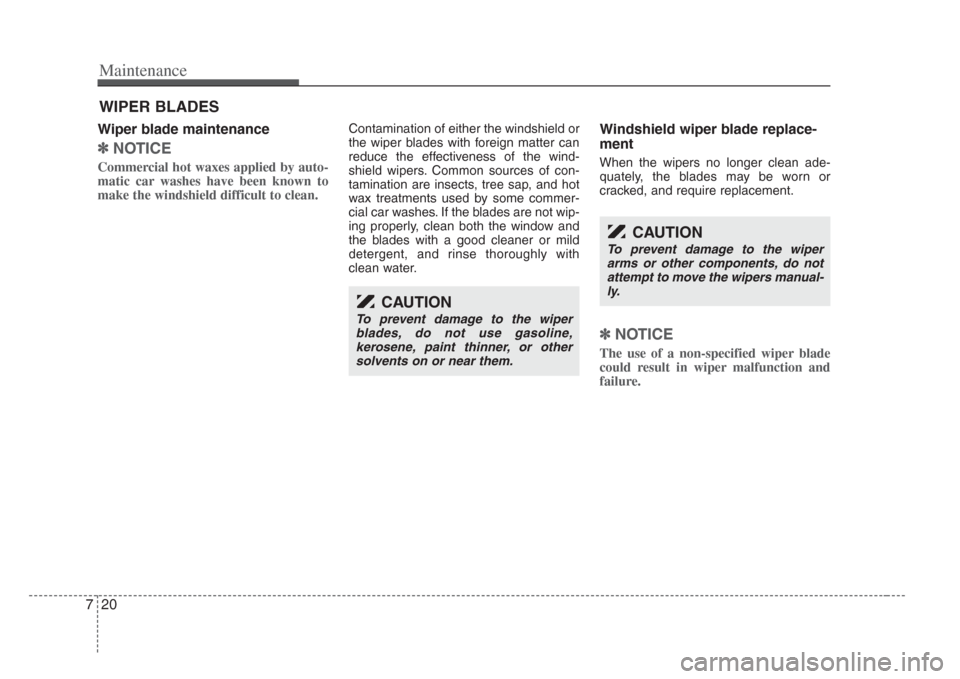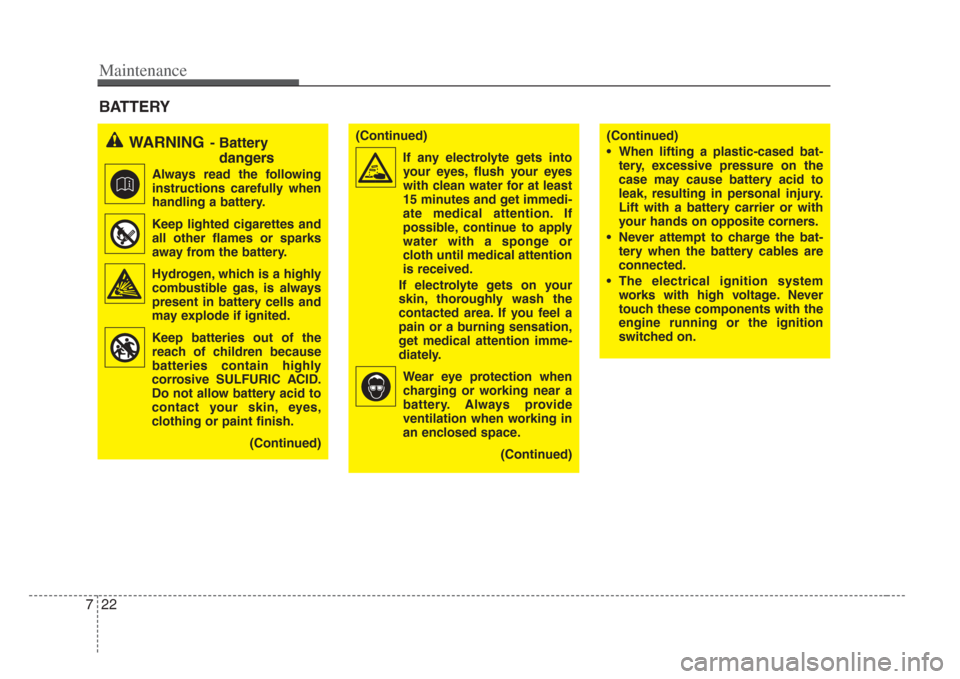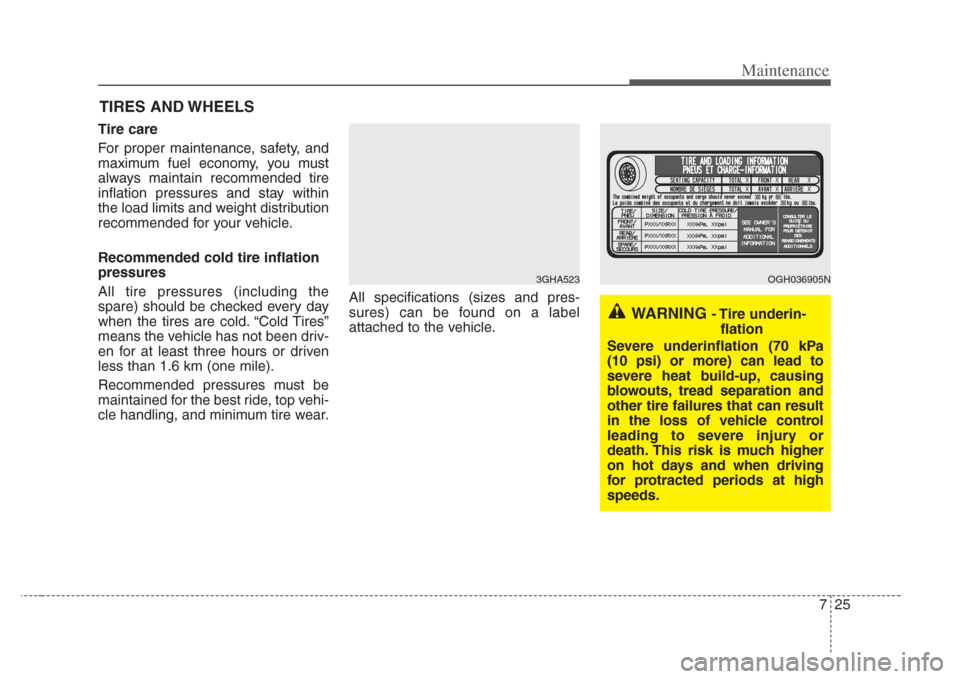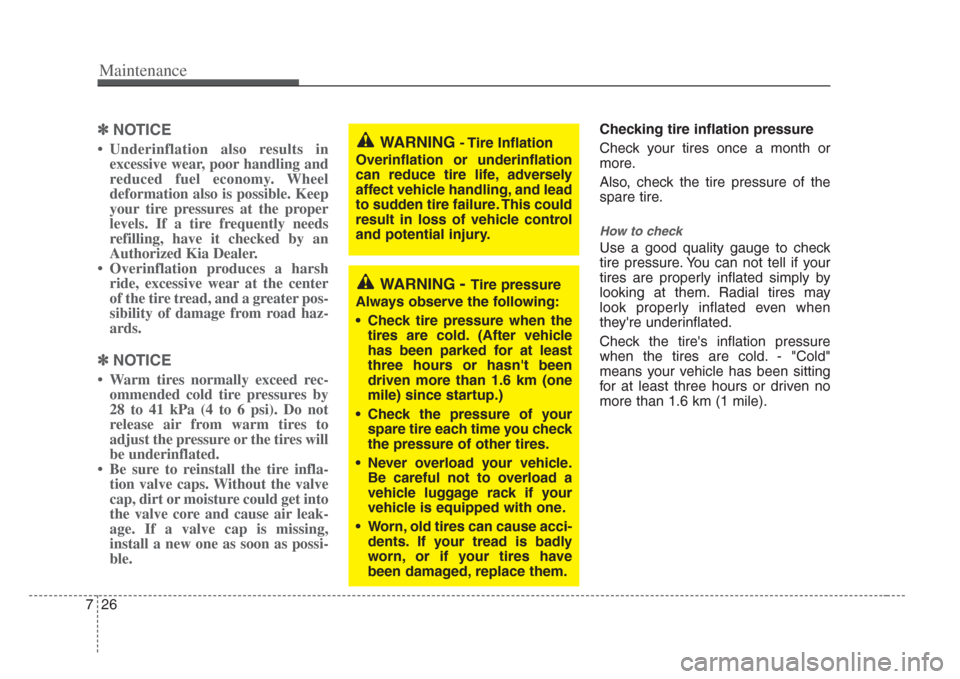Page 254 of 283

719
Maintenance
AIR CLEANER
Element replacement
Have the air cleaner element checked
and replaced in accordance with the
maintenance schedule.The climate control air filter located
between the evaporator core and blower
filters the air coming into the vehicle.
If dust or other pollutants accumulate in
the filter for a period of time, the air flow
from the air vents may be decreased and
the dust intake may increase. Therefore
the air filter should be replaced at the
intervals shown in the maintenance
schedule. If the vehicle is operated in
dusty or sandy areas, replace the filter
more often than the recommended inter-
vals.
CLIMATE CONTROL AIR FILTER (IF EQUIPPED)
OGH056911N
Evaporator core
Blower
Outside air
Recirculated air
Climate control air filter
Inside
vehicle
CAUTION
• Do not drive with the air cleaner
removed; thi s will result in exces-
sive engine wear.
• Driving without an air cleaner encourages backfiring, which
could cause a fire in the engine compartment.
• When removing the air cleaner element, be careful that du st or
dirt does not enter the air intake, or damage may result.
OGH057009
Page 255 of 283

Maintenance
207
WIPER BLADES
Wiper blade maintenance
✽NOTICE
Commercial hot waxes applied by auto-
matic car washes have been known to
make the windshield difficult to clean.
Contamination of either the windshield or
the wiper blades with foreign matter can
reduce the effectiveness of the wind-
shield wipers. Common sources of con-
tamination are insects, tree sap, and hot
wax treatments used by some commer-
cial car washes. If the blades are not wip-
ing properly, clean both the window and
the blades with a good cleaner or mild
detergent, and rinse thoroughly with
clean water.Windshield wiper blade replace-
ment
When the wipers no longer clean ade-
quately, the blades may be worn or
cracked, and require replacement.
✽NOTICE
The use of a non-specified wiper blade
could result in wiper malfunction and
failure.
CAUTION
To prevent damage to the wiper
blades , do not us e gasoline,
keros ene, paint thinner, or other
solvents on or near them.
CAUTION
To prevent damage to the wiper arms or other components, do notattempt to move the wiper s manual-
ly.
Page 256 of 283
721
Maintenance
1. Raise the wiper arm and turn the wiperblade assembly to expose the plastic
locking clip.
✽NOTICE
Do not allow the wiper arm to fall
against the windshield, since it may chip
or crack the windshield.
2. Compress the clip and slide the blade
assembly downward. 3. Lift it off the arm.
4. Install the blade assembly in the
reverse order of removal.
1JBA70371JBA70381LDA5023
Page 257 of 283

Maintenance
227
(Continued)
• When lifting a plastic-cased bat-tery, excessive pressure on the
case may cause battery acid to
leak, resulting in per sonal injury.
Lift with a battery carrier or with
your hands on opposite corner s.
• Never attempt to charge the bat- tery when the battery cable s are
connected.
• The electrical ignition s ystem
works with high voltage. Never
touch these components with the
engine running or the ignition
s witched on.
BATTERY
WARNING- Battery
danger s
Always read the following
instructions carefully when
handling a battery.
Keep lighted cigarette s and
all other flames or sparks
away from the battery.
Hydrogen, which i s a highly
combustible gas,i s always
present in battery cells and
may explode if ignited.
Keep batteries out of the reach of children because
batteries contain highly
corrosive SULFURIC ACID.
Do not allow battery acid to
contact your s kin, eyes,
clothing or paint finish.
(Continued)
(Continued)If any electrolyte gets intoyour eyes, flush your eyes
with clean water for at lea st
15 minutes and get immedi-
ate medical attention. If
possible, continue to apply
water with a s ponge or
cloth until medical attention
is received.
If electrolyte gets on your
s kin, thoroughly was h the
contacted area. If you feel a
pain or a burning sensation,
get medical attention imme-
diately.
Wear eye protection whencharging or working near a
battery. Always provide
ventilation when working in
an enclosed space.
(Continued)
Page 258 of 283

723
Maintenance
For best battery service :
• Keep the battery securely mounted.
• Keep the battery top clean and dry.
• Keep the terminals and connectionsclean, tight, and coated with petroleum
jelly or terminal grease.
• Rinse any spilled electrolyte from the battery immediately with a solution of
water and baking soda.
• If the vehicle is not going to be used for an extended time, disconnect the bat-
tery cables.
Battery recharging
Your vehicle has a maintenance-free,
calcium-based battery.
• If the battery becomes discharged in ashort time (because, for example, the
headlights or interior lights were left on
while the vehicle was not in use),
recharge it by slow charging (trickle)
for 10 hours.
• If the battery gradually discharges because of high electric load while the
vehicle is being used, recharge it at 20-
30A for two hours.
Items to be reset after the battery ha s
been discharged or the battery ha s
been disconnected.
• Driver seat position memory system (See Chapter 3)
• Power window (See Chapter 3)
• Clock (See Chapter 3)
• Climate control system (See Chapter 4)
• Audio (See Chapter 3)
• Sunroof (See Chapter 3)
CBGQ0705
Page 259 of 283

Maintenance
247
✽NOTICE
Before performing maintenance or
recharging the battery, turn off all
accessories and stop the engine.
The negative battery cable must be removed first and installed last when
the battery is disconnected.
WARNING- Recharging
battery
When recharging the battery,
observe the following precaution s:
• The battery mus t be removed
from the vehicle and placed in an
area with good ventilation.
• Do not allow cigarette s,sparks,or
flame near the battery.
• Watch the battery during charg- ing, and stop or reduce the charg-
ing rate if the battery cells begin
gassing (boiling) violently or if
the temperature of the electrolyte
of any cell exceeds 49°C (120°F).
• Wear eye protection when check- ing the battery during charging.
(Continued)
(Continued)
•Disconnect the battery charger in
the following order.
1. Turn off the battery charger main switch.
2. Unhook the negative clamp from the negative battery terminal.
3. Unhook the positive clamp from the positive battery terminal.
Page 260 of 283

725
Maintenance
TIRES AND WHEELS
Tire care
For proper maintenance, safety, and
maximum fuel economy, you must
always maintain recommended tire
inflation pressures and stay within
the load limits and weight distribution
recommended for your vehicle.
Recommended cold tire inflation
pressures
All tire pressures (including the
spare) should be checked every day
when the tires are cold. “Cold Tires”
means the vehicle has not been driv-
en for at least three hours or driven
less than 1.6 km (one mile).
Recommended pressures must be
maintained for the best ride, top vehi-
cle handling, and minimum tire wear. All specifications (sizes and pres-
sures) can be found on a label
attached to the vehicle.
3GHA523
XXX XX XX
XXX XX XXX XX
XXX XX
XXX XX XX
XXX XX XX
X
X
X
X X
X
390390860860390390860860
OGH036905N
WARNING - Tire underin-
flation
Severe underinflation (70 kPa
(10 ps i) or more) can lead to
s evere heat build-up, caus ing
blowouts , tread separation and
other tire failures that can result
in the loss of vehicle control
leading to s evere injury or
death. This risk is much higher
on hot days and when driving
for protracted periods at high
s peeds .
Page 261 of 283

Maintenance
267
✽NOTICE
Underinflation also results in
excessive wear, poor handling and
reduced fuel economy. Wheel
deformation also is possible. Keep
your tire pressures at the proper
levels. If a tire frequently needs
refilling, have it checked by an
Authorized Kia Dealer.
Overinflation produces a harsh ride, excessive wear at the center
of the tire tread, and a greater pos-
sibility of damage from road haz-
ards.
✽ NOTICE
Warm tires normally exceed rec-
ommended cold tire pressures by
28 to 41 kPa (4 to 6 psi). Do not
release air from warm tires to
adjust the pressure or the tires will
be underinflated.
Be sure to reinstall the tire infla- tion valve caps. Without the valve
cap, dirt or moisture could get into
the valve core and cause air leak-
age. If a valve cap is missing,
install a new one as soon as possi-
ble.
Checking tire inflation pressure
Check your tires once a month or
more.
Also, check the tire pressure of the
spare tire.
How to check
Use a good quality gauge to check
tire pressure. You can not tell if your
tires are properly inflated simply by
looking at them. Radial tires may
look properly inflated even when
they're underinflated.
Check the tire's inflation pressure
when the tires are cold. - "Cold"
means your vehicle has been sitting
for at least three hours or driven no
more than 1.6 km (1 mile).
WARNING- Tire Inflation
Overinflation or underinflation
can reduce tire life, adver sely
affect vehicle handling, and lead
to sudden tire failure. Thi s could
result in lo ss of vehicle control
and potential injury.
WARNING-Tire pressure
Always observe the following:
• Check tire pressure when the tires are cold. (After vehicle
has been parked for at least
three hour s or has n't been
driven more than 1.6 km (one
mile) since startup.)
• Check the pressure of your spare tire each time you check
the pressure of other tires.
• Never overload your vehicle. Be careful not to overload a
vehicle luggage rack if your
vehicle is equipped with one.
• Worn, old tires can cause acci- dents. If your tread is badly
worn, or if your tires have
been damaged, replace them.